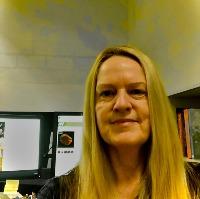Lee-Anne Raymond is Manager of MV Images (DAMS) at Museums Victoria, Australia
This year’s theme Breaking Down Barriers invokes imagery of protest marches, placards, actors suddenly bursting into song… Just me? Likely. Too much streaming in long lockdowns. Honestly, I really had to mull on the theme a bit, as I was concerned. How could I determine that barriers are being broken down from within a Museum where we do a lot of digitisation for reasons of physical preservation and access?
It helped to frame my post this way. In terms of digital preservation, what are the barriers Museums break down?
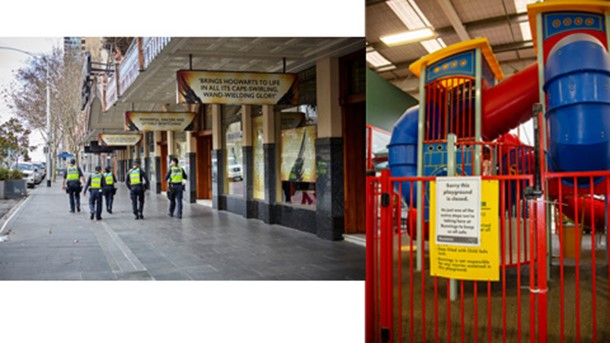
L-R: Police Patrolling Streets of Melbourne During Covid-19 Pandemic Lockdown, Spring Street, Melbourne, July 2020: COVID-19 Pandemic Collection 2020. CC BY MV 2020 / Photographer: Lorenzo Iozzi.
Closed playground at a Bunnings Warehouse, Vermont South, June 2020 - COVID-19: COVID-19 Pandemic Collection 2020. ©MV 2020 / Photographer: Rodney Start
Digital preservation is in the capture of provenance, authenticity, fixity, rights, and the technical integrity of the digital content. It is critical these unique characteristics remain intact, unaltered and in connection with the content. By extension managed and resourced content in systems with dedicated secure storage, that are documented, discoverable, rights and access ready, with access versioning, along with the capture and monitoring of source information and technical integrity addressed, ensure retention and longevity. Which as workflow and undertaking can represent a daunting barrier.
At MV the activity of digitisation of collections has been running over several decades. Gradually over the last decade digital preservation actions have become firmly embedded within digitisation and born digital acquisition workflows. Over time Digital Preservation Workflow activities have come to be modelled through key stages that work for MV’s conditions, such as; quarantine and quality assurance checks, selection and transfer, ingest preparation, systematic recording of checksum, programmed fixity checks, at acquisition capture of provenance, discoverability, rights information and use capture. At ingest scripted actions ensure Preservation Masters are sent to secure storage and or for unusually large files, are deployed into more appropriate network storage. To address or anticipate format obsolescence (in particular of proprietary or listed endangered formats), conversion or transcoding takes place prior ingest with source formats transferred to limited access Archive. Relationship between source format and Preservation Master are maintained through strict standards adapted to conform to MV’s DAMS and CMS integration specifications. Enhancement is planned to further ensure management of Preservation Masters has increased rigour in the integrated systems.
Barriers Broken Down
Over decades MV has amassed hundreds of thousands of high value digital files to detail and provide access to the physical collections. Attendant to this is has been a maturing capability to create new and acquire born digital content that complement the existing physical collections. Some now represent standalone, born digital collections with their own unique significance for creation on their own terms. In addition their management has demanded appropriate technical rigour. These emerging new standalone digital collections, plus increases in born digital acquisitions, has seen technicians and digital content managers operate in ever more cooperative ways. Preserving these digital collections has had a comparative great leap forward at MV as a consequence.
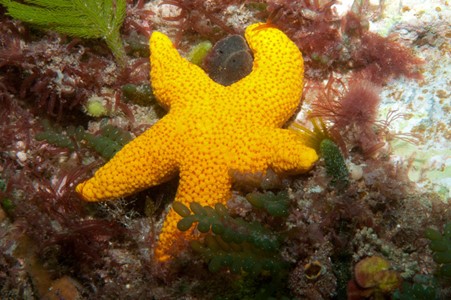
Fromia polypora, Seastar. Location: Australia, Victoria, Cape Paterson, Bunurong Marine National Park, Twin Reefs. CC BY-NC MV 2012 / Photographer: Julian Finn
Born digital acquisition and created new collections now have well understood handling practice and protocol ensuring safe carriage, analysis, technical and other quality checks are conducted prior files simply hitting the network via copy>paste or a hard drive dump. Integrity of the content is assured under the workflow that provides a directly managed pathway with checks prior to arriving on the network. Transfer, ingest and documenting into systems is managed by skilled staff. It is understood that ensuring existing technical metadata and format arrive unaltered and intact is critical to asset integrity and if lost or damaged the acquisition is in jeopardy.
Significantly systems integrations are mirrored by human resources integration. As noted above recognising and utilising the complementary skills of collections and digital content experts ensures safe capture, ‘handling’, ingest, management and appraisal are conducted in the most efficient way for delivery of content to target access and future use contexts.
Access Significance and Preservation
Where digitisation of collections crosses into digital preservation is in the detailed capture of some unique objects from every angle possible, and in the utilising of unconventional technologies to do so. Why, depends on the object, its significance and size, for example: An object might be both irreplaceably unique and simply too large to faithfully document conventionally.
Like a building. In this case faithfully scaled 3D representations.
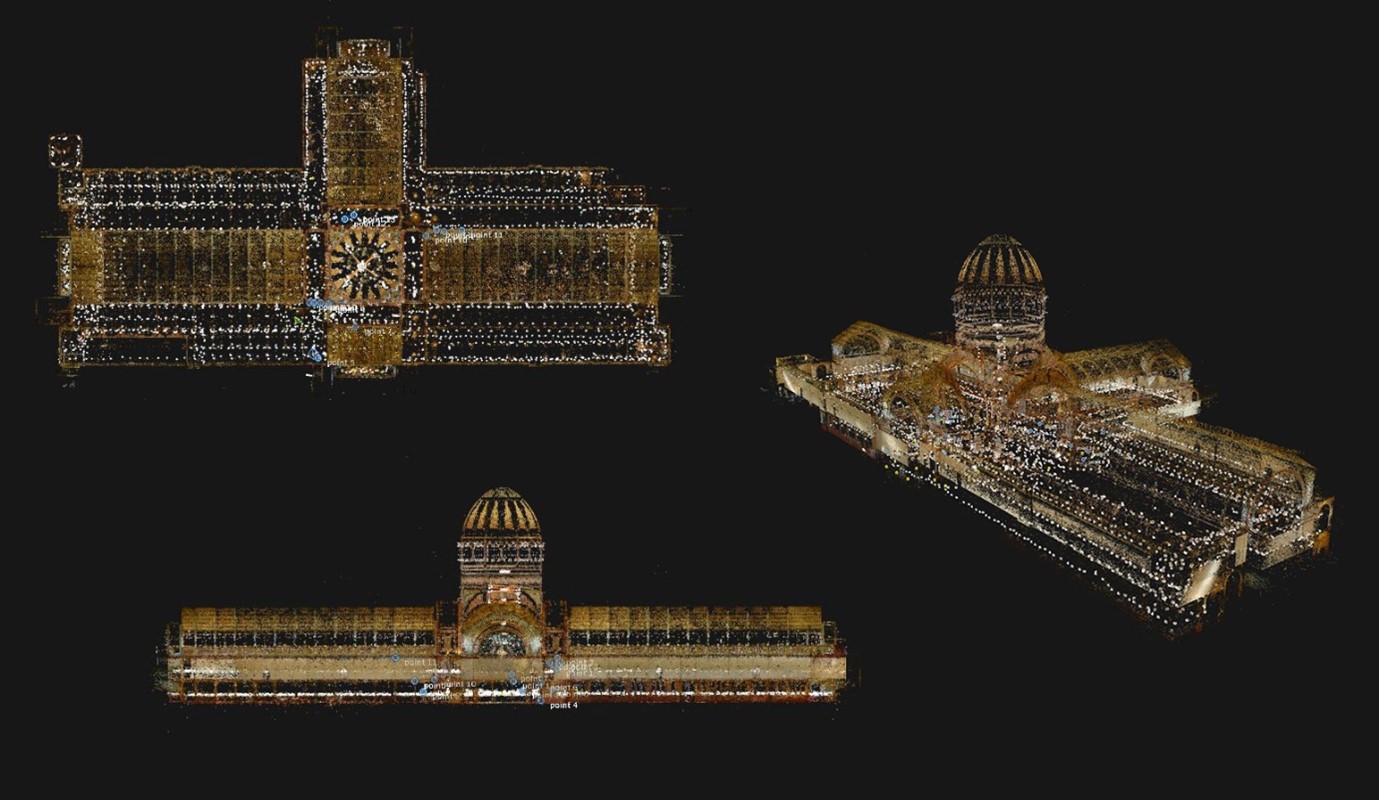
Screenshot of views from 3D rendered model of The Royal Exhibition Building, Melbourne. ©MV 2018 / Creator: CyArk
Unconventional digitisation such as that performed on the basking shark below-left, retrieved by a fishing trawler, realised a wealth of information through faithful 3D representations for scientific research and study. The remains of the animal required rigging and scaffolded suspension to permit scanning. The result is a digitised necropsy permitting a unique morphological examination by researchers. A most recent use being made by researcher from the Department of Biomaterials Max Planck Institute of Colloids and Interfaces. The newly acquired Melbourne Triceratops is undergoing documentation procedures more akin to medical examinations such as CT-Scanning below-right. The results will build a new born digital collection for access, research, uses by the collection or not yet imagined, as well as digital preservation.
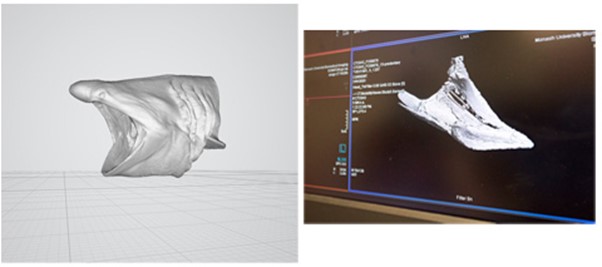
L-R: 3D render of the head of Cetorhinus maximus, Basking Shark specimen. MV 2015 / Creator: Ben Tam, courtesy of Qubic.
Screen showing Triceratops CT scan documentation: Monash University. ©MV 2021 / Photographer: Tim Ziegler
Other purposes for detailed digitisation and digital preservation are so as to limit re-handling of unique, impossibly fragile physical objects. To provision for research access, as a record in the event of deterioration and, in particular, due to their uniqueness, are paramount. These digital representations created for preventative conservation and preservation, in one context, dually act as a time-capsule informing on the deterioration of the physical. Materially, this holotype specimen holds great value for its reference significance and its physical form.
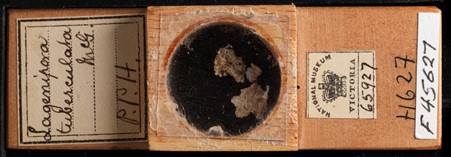
Microslide of bryozoan holotype specimen, Lagenipora tuberculata.
CC BY: MV 2015 / Photographer: Jon Augier
The need to access collections online or remotely during the pandemic lockdowns has reinforced the relevance of the historic strong investment by museums in digitisation of collections. It has been emphatically emphasised such an investment breaks down accessibility barriers to the collections that exist for reasons of mobility, distance, time or even a public health enforced period of lock down. This not only demonstrates that our growing digitisation of collections matter but that our emerging born digital collections matter.
Importantly their preservation create greater investigative pathways for interpretation, discovery and advancing understanding through greater accessibility.
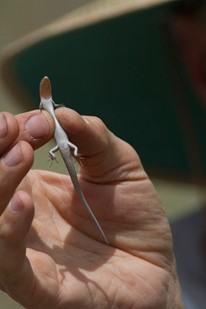
Morethia boulengeri, South-Eastern Morethia Skink, The Boulenger's Skink. Location: Australia, Victoria, Neds Corner, Homestead lab. Survey: Neds Corner Bush Blitz, BBNC 924.
CC BY-NC: MV 2011 / Photographer: David Paul
Capturing Digital Memory to Break Down Barriers
Whilst digitisation for collection’s access functions as a well understood justifiable funding practice, it is in the growing born digital collections we are creating and acquiring that future funding models need to anticipate and deliver on.
I imagine the way forward, for Museums and Galleries in particular, to be partly answered by the employ of complimentary digital asset management and digital preservation system solutions. That these combined will best manage and service established collection management systems requiring access to, but not the responsibility for managing use and preservation of emerging cultural heritage and sciences digital collections.
Delivery of digitisation for access activities require layers of cooperative practice, procedures and skills that are uniquely primed for extension and application into digital preservation. These are already cooperative practices informed over many years. We know, when we have had to, we can pivot our high quality digitisation of collections strategies and skills to lean into digital preservation for emergent digital collections and that this only expands the future reach and value of those collections. Born digital content created by institutions for the augmentation of existing or development of new collections are building as trusted source, standalone, digital collections to inform, lead and inspire current and future research and researchers.
It is all about breaking down barriers to preserve memory and knowledge for current and future access.
